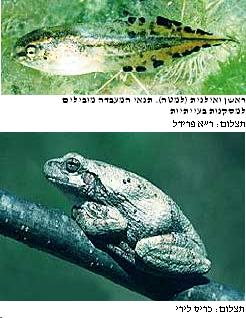What amount of pesticide kills a particular animal? * It turns out that the answer changes radically depending on other environmental pressures exerted on the animal
Zafarir Rinat

Scientists who test the toxicity of various chemical substances do so by exposing animals to these substances under laboratory conditions. The scientists check the concentration of the substance that kills half of the animals, and this concentration is defined as toxic and serves as a basis for calculating the amount of the substance dangerous to the environment.
But to what extent are experiments of this type valid when it comes to natural conditions, outside the laboratory? According to a study recently published in the American journal "Ecological Applications", the effect of chemical substances on animals is much greater under conditions that simulate the natural environment and include exposure to predators. The combined stress of exposure to a toxic substance and the threat of predators caused the death of the animals on which the study was conducted, even though the concentration of the toxic substance was only a few percent of the rate defined as toxic based on
The research was conducted by Rick Ralia and Nathan Mills from the Universities of Pittsburgh and Missouri in the United States. They decided to study amphibians, whose numbers have decreased in recent years, and focused on amphibians of the species Ilanit. One of the explanations for the decline of amphibians is the effect of pollutants, especially pesticides.
The researchers looked at what happens to tadpoles after they are exposed to a common pesticide called carbamil. They added another very important variable to the test - the ambystoma, an amphibian that is a natural predator of wood tadpoles. The Ambystoma was placed in cages next to the tadpoles; He didn't prey on them, but he secreted chemicals that caused them to develop all the behavioral characteristics of a response to the danger of predation.
The researchers tested the effect of the pesticide on tadpoles without and in the presence of predators. Without the presence of predators, the degree of survival of the tadpoles was similar to the assessment given according to previous laboratory experiments: after a few days' exposure to high concentrations of the pesticide, most of the tadpoles died. But when they were placed near the caged tadpoles with ambystomas the picture was different. This time the tadpoles were exposed to a much lower concentration of the pesticide, less than three percent of the concentration considered lethal. After four days, no effect of the pesticides on the ambystomas was evident, but after a week it became clear that despite the low concentration, 97% of the tadpoles died.
The researchers do not have a full explanation for the question of why the combination of exposure to a pesticide and predators causes such a far-reaching effect, but it is clear that the combination has an effect, because when the tadpoles were only exposed to a low concentration of the pesticide, or only to predators, it had only a small effect. It is possible that the presence of the predators caused stress in the tadpoles, which increased the physiological stress they were already under due to the exposure to the pesticide.
Although this is a study conducted on only one species of animal, the two researchers state that drawing conclusions about the risk of long-term exposure of wild animals to pesticides based on short-term studies conducted under laboratory conditions is extremely problematic. The results of the study are particularly alarming because many water bodies where the tadpoles live in the United States have carbamyl concentrations similar to those that caused death in the laboratory experiment where the tadpoles were exposed to predators.
Both researchers believe that additional variables that exist in nature should be tested in the laboratory studies. Other researchers, who were asked to comment on the results of the study, added that studies should also be conducted in nature and check the extent of amphibian mortality in different areas.
Scientists are already demanding that such tests be conducted on the pesticide atrazine, the most widely used herbicide in the world. According to one study, conducted by Tyrone Hayes in the laboratories of the University of Berkeley, this substance damages the hormonal system of amphibians. However, after the study was published, the US Environmental Protection Agency decided to conduct another review of all the atrazine studies and decided that they were all wrong and that more studies should be conducted. In response, Hayes claimed that the agency was influenced by flawed studies by the atrazine industry.
